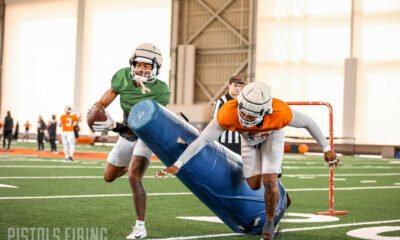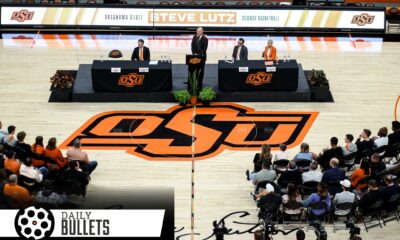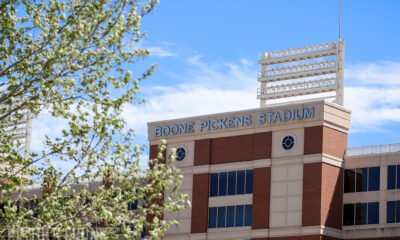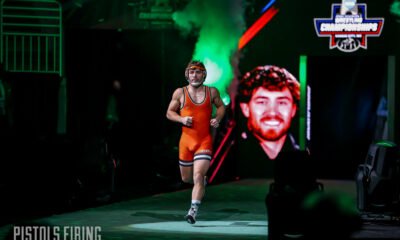Football
Five Things to Know About the NCAA’s New Rule Changes and How they Affect OSU
On Wednesday the NCAA announced sweeping rule changes — some of which will be set into action immediately, others that are no more than framework that require being built out — that directly impact college athletics. More specifically, college basketball.
The changes were announced, more or less, in response to the ongoing FBI probe into corruption within the sport in an effort to clean up its dark underbelly.
Whether or not that goal was accomplished is definitely up for debate (Dan Wetzel called the changed no more than a smoke-and-mirror show, and Jay Bilas called it meaningless window dressing), but it doesn’t change the fact that there are real initiatives now set in place that will be enacted to change the game.
Here are five things to know about those changes and how it might impact Oklahoma State.
1. Players can return to school if they go undrafted
I’m all for this rule change, which states that any undrafted player can either return to school to finish their degree or continue their pursuit of a professional career elsewhere if they don’t get drafted. The caveat, however, is a killer: This only applies to player who are invited to the NBA Combine. So the Tavarius Shine’s and Yankuba Sima’s of the world will still be left in a bubble.
2. “Elite” high school, college athletes can have agent relationships
A doozy. And one that remains murky. The NCAA says it will now allow “elite prospects” — (no definition on the word elite) — to have official relationships with agents, including high school or college athletes. But the problem is … the NCAA has cornered itself.
It announced Wednesday that it will work in conjunction with USA Basketball to identify which prospects are tabbed as “elite” in any given class, but USA Basketball heard of this proposal and responded with, “New phone, who dis?”
From ESPN.
Top officials with the NBA and USA Basketball were blindsided by the timing of and changes in the NCAA’s announcement of future rules regarding pro basketball prospects, sources told ESPN.
The NCAA launched a commission and set of subcommittees to address the fallout from the FBI investigation into the college basketball industry, resulting in several policy shifts, including the assigning of responsibility to USA Basketball for something the organization had already told the NCAA it wanted no part: bearing responsibility for selecting elite senior high school prospects who will be allowed to sign with registered agents.
USA Basketball doesn’t have the infrastructure or interest in accepting the role of evaluating the nation’s top prospects for a yet-to-be-determined number of players who will annually be allowed to sign with agents at the end of their junior years, sources told ESPN. [ESPN]
Not great! This rule change isn’t likely to impact Oklahoma State with regards to high schoolers. Assuming “elite” prospects are only top-15 or so for each class, OSU will rarely be involved with them. But it could play a factor with student-athletes, who will now be given the freedom to have official relationships with agents.
3. The recruiting calendar is changing, for the worse
Part of the new changes will allow, for the first time ever, college coaches to attend the NBA Players Association Top 100 camp each June. That’s good news. However, the calendar is getting mashed up considerably.
According to my colleague Matt Norlander, coaches will now have less time to see more prospects on the AAU circuit during July, a month which includes Peach Jam and events with Nike and Adidas across the country at various times.
In July, coaches will be moved from from three weekends to one when it comes to attending sanctioned, non-scholastic (so-called “AAU”) events. The earliest five-day July evaluation period will remain in place; coaches will still be able to attend Nike’s Peach Jam and other non-scholastic tournaments in that window. The month itself is shrinking from three recruiting weekends to two, with the second featuring camp-style events that will be coordinated by the NCAA, USA Basketball, the NBA and the NBA Players Association. [CBS Sports]
Norlander and Gary Parrish podcasted on Wednesday and both said they talked with coaches on this specific proposal, and no one was happy about it. It essentially requires more work in less time, and less opportunities for high schoolers to be uncovered at officially sponsored events by college coaches.
4. The NCAA is requiring presidential, chancellor, staff contractual investigate compliance
This one is a tricky one, but the NCAA is essentially seeking power commensurate with subpoena it previously lacked by requiring all school presidents, chancellors and athletics’ staffers to contractually comply with any/all investigations.
This rule will require those previously mentioned to report to their respective university any income they receive from business ads, apparel companies, and more with hopes of creating a more transparent system for all involved. This rule is in direct response to the FBI investigation into the sport.
Again, I turn to Norlander to break down some of the nuances of this one:
The FBI’s case into college basketball brought about mounds of documents of information. Previously, the NCAA did not allow for information and findings from outside investigations at established agencies to be used in its infractions process. Effective immediately, the NCAA and its Committee on Infractions can use information obtained in other probes as a means to an end for its own investigations. This will be implemented immediately by the NCAA with the schools currently caught up in the Department of Justice’s case regarding multiple schools — and alleged violations of multiple federal laws. [CBS Sports]
5. The crux of the NBA Draft rule change
Student-athlete empowerment is great, and the NCAA is seemingly moving, albeit sluggishly, to a model in which they will have more power than ever. Allowing those invited to the combine that don’t get drafted to return to school is a step in that direction.
But that specific step is also very complicated. As implemented in the past few years, players who declare for the draft but don’t get the feedback they feel is worth leaving school for can return to school, so long as they announce the decision officially within 10 days of the conclusion of the NBA Combine. Under the new set of rules (noted in point No. 1), players can now return to school a month after the combine. That leaves college coaches on the hook to play the guessing game with scholarship numbers all the way up until the end of June … which is less than ideal.

-

 Football5 days ago
Football5 days agoNotebook: Stribling Back, Clay Squatting 635 and Glass Fitting in Well
-

 Daily Bullets4 days ago
Daily Bullets4 days agoDaily Bullets (Apr. 19): Bedlam Gametime Moved, Cowboy Receivers Breed Confidence
-

 Football4 days ago
Football4 days agoFour-Star Wide Receiver Jaden Perez Commits to Oklahoma State
-

 Wrestling5 days ago
Wrestling5 days agoOSU Wrestling: After Disappointing College Career Ending, Daton Fix Eyes Bigger Goal at Olympic Team Trials






